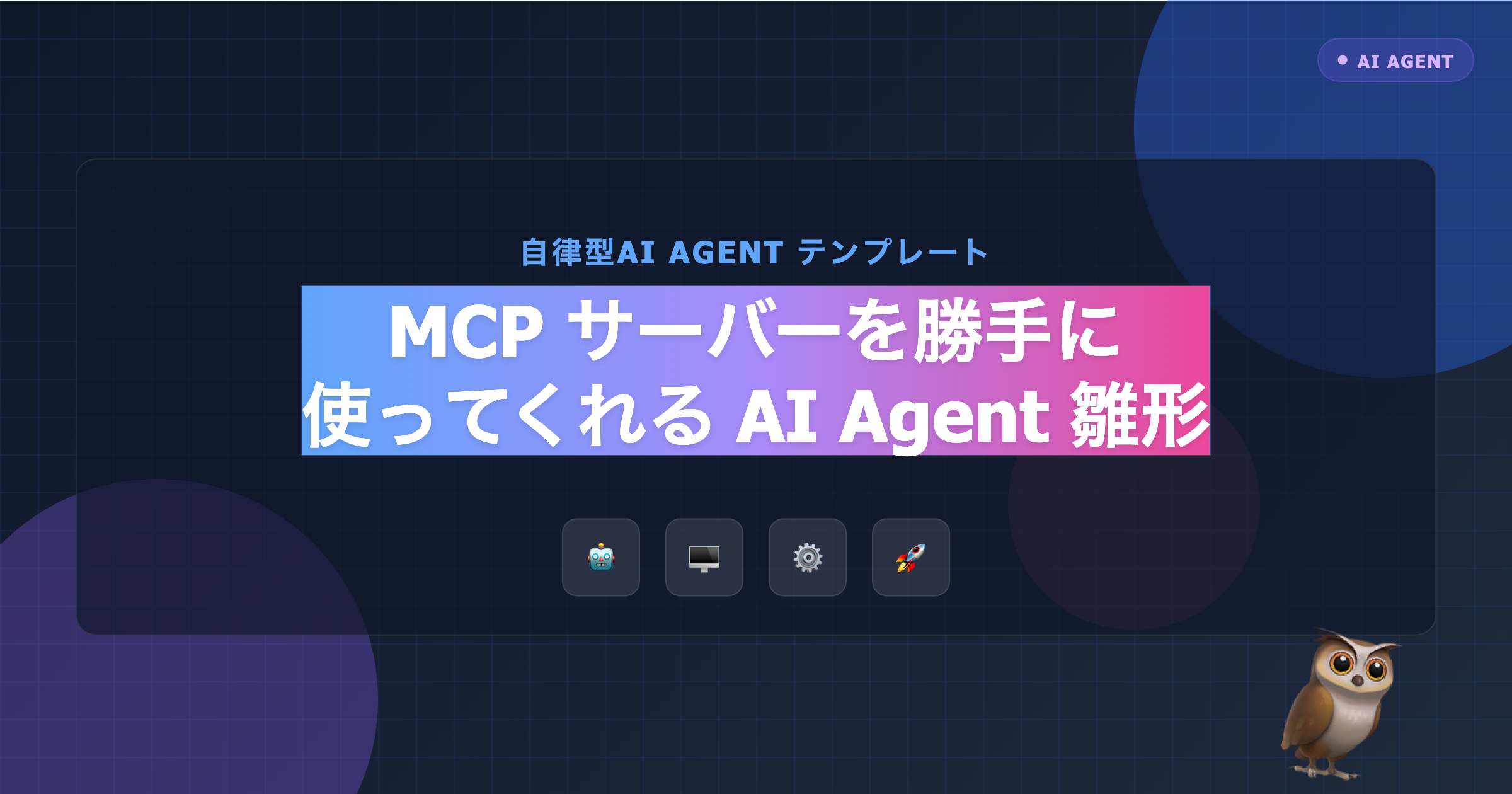ブログのOGP画像はClaudeに作らせてるんですが、今回みたいにめっちゃダサいのでてきてこういうの楽しい。
AI Agent作りたい
世の中にモデルコンテキストプロトコル(MCP)がでてきました。
僕も、本格的に一部タスクを裏で勝手にやっといてくれるAgentを作っていこう、という気になっています。
MCPというよりはいままであんまり触ってなかったTools周りの設定をAIアプリにいれていけることまでは勉強しとこうかなと思います。
Agent基盤の目論見
- (1)プロダクションではおそらくAWS Bedrock使うだろう
- とはいえBedrock依存しすぎずLangChain系の実装使っておきたい
- (2) 対話ではなく最初に与えた指示を勝手に完遂してもらおう
- Toolをぐるぐるまわして自己判断してもらおう
- (3) MCP経由で自由にToolはつかってもらおう
このへんの要件を自分で決め、作った(作らせた...?)ものが以下。
{
"name": "agent-node-demo",
"version": "1.0.0",
"type": "module",
"scripts": {
"mcp-client": "node --loader ts-node/esm src/bin/mcp-client-once.ts",
"test": "echo \"Error: no test specified\" && exit 1"
},
"author": "",
"license": "ISC",
"description": "",
"dependencies": {
"@langchain/aws": "^0.1.7",
"@langchain/core": "^0.3.42",
"@types/node": "^22.13.10",
"dotenv": "^16.4.7",
"mcp-langchain-ts-client": "^0.0.3",
"ts-node": "^10.9.2",
"typescript": "^5.8.2"
}
}
import { MCPToolkit, StdioServerParameters } from "mcp-langchain-ts-client";
import { ChatBedrockConverse } from "@langchain/aws";
import { HumanMessage, SystemMessage } from "@langchain/core/messages";
import { ToolCall, ToolMessage } from "@langchain/core/messages/tool";
import dotenv from "dotenv";
// 環境変数の読み込み
dotenv.config();
// AWS Bedrockの設定
const region = "us-east-1";
async function main() {
console.log("AI Agent with MCP starting...");
// 環境変数からメッセージを取得
const commandMessage = process.env.COMMEND_MESSAGE;
if (!commandMessage) {
console.error("環境変数 COMMEND_MESSAGE が設定されていません。");
process.exit(1);
}
try {
// Bedrockモデルの初期化
const model = new ChatBedrockConverse({
// 推論プロファイルを含むモデルARNを指定
model: "arn:aws:bedrock:us-east-1:xxxxxxxx:inference-profile/us.anthropic.claude-3-5-sonnet-20240620-v1:0",
region,
// AWS認証情報は~/.aws/credentialsから自動的に読み込まれる
temperature: 0.7,
maxTokens: 4000,
});
// MCPサーバーの設定(使わないけどサンプル)
const serverParams1: StdioServerParameters = {
command: "npx",
args: [
"-y",
"@modelcontextprotocol/server-everything"
]
};
// 自分で作った検索/スクレイピングのMCPサーバーの設定
const serverParams2: StdioServerParameters = {
command: "xxxxxxx",
args: [],
env: {}
};
// MCPツールキットの初期化(サーバー1)
const toolkit1 = new MCPToolkit(serverParams1);
await toolkit1.initialize();
// MCPツールキットの初期化(サーバー2)
const toolkit2 = new MCPToolkit(serverParams2);
await toolkit2.initialize();
// 両方のMCPツールを結合
const tools = [...toolkit1.tools, ...toolkit2.tools];
console.log(`利用可能なMCPツール: ${tools.map(tool => tool.name).join(", ")}`);
// ツールの詳細をログに出力
//tools.forEach(tool => {
// console.log(`ツール名: ${tool.name}`);
// console.log(`説明: ${tool.description}`);
// console.log(`スキーマ: ${JSON.stringify(tool.schema, null, 2)}`);
// console.log("---");
//});
// モデルにツールをバインド
const modelWithTools = model.bindTools(tools);
// ツール結果の型定義
interface ToolResult {
toolName: string;
toolCallId: string;
result: string | object;
}
// ツール実行関数
async function executeTools(toolCalls: ToolCall[]): Promise<ToolResult[]> {
console.log(`ツール呼び出し: ${JSON.stringify(toolCalls, null, 2)}`);
const results = [];
for (const call of toolCalls) {
try {
const tool = tools.find(t => t.name === call.name);
if (tool) {
console.log(`ツール実行: ${call.name}`);
const result = await tool.invoke(call.args);
console.log(`#################################3`)
console.log(`ツール実行した。 (${call.name})`);
console.log(`#################################3`)
// console.log(`ツール実行結果 (${call.name}): `, JSON.stringify(result, null, 2));
results.push({
toolName: call.name,
toolCallId: call.id || `call-${Date.now()}`,
result: result
});
}
} catch (error) {
console.error(`ツール実行エラー (${call.name}):`, error);
const errorMessage = error instanceof Error ? error.message : '不明なエラー';
results.push({
toolName: call.name,
toolCallId: call.id || `error-${Date.now()}`,
result: `エラー: ${errorMessage}`
});
}
}
return results;
}
console.log("AIエージェントが起動しました。環境変数から指定されたタスクを実行します。");
console.log(`実行タスク: ${commandMessage}`);
try {
// 会話履歴の初期化
const systemMessage = new SystemMessage(
`あなたは利用可能なツールを使って指定されたタスクを忠実に実行するAIアシスタントです。
以下のツールが利用可能です:
${tools.map(tool => `- ${tool.name}: ${tool.description}`).join('\n')}
特にWeb検索、スクレイピングのツールを積極的に使ってください:
タスクの実行に必要な場合は、これらのツールを使用してください。
ツールを使う際は、適切な引数を指定してください。`
);
const messages = [systemMessage, new HumanMessage(commandMessage)];
// AIモデルにタスクを送信
const response = await modelWithTools.invoke(messages, {
tool_choice: "auto"
});
console.log(`AIモデルの応答: ${JSON.stringify(response, null, 2)}`);
console.log("\nAI応答:");
console.log(response.content);
// ツール呼び出しを処理する再帰関数
async function processToolCalls(currentResponse: any, currentMessages: any[]) {
if (currentResponse.tool_calls && currentResponse.tool_calls.length > 0) {
console.log("\nツール呼び出しを検出しました。実行中...");
const toolResults = await executeTools(currentResponse.tool_calls);
// ツール結果をAIに送信して続行
currentMessages.push(currentResponse);
for (const result of toolResults) {
// ツール結果をメッセージとして追加
currentMessages.push(new ToolMessage({
content: typeof result.result === 'string' ? result.result : JSON.stringify(result.result),
tool_call_id: result.toolCallId,
name: result.toolName
}));
}
// 続行レスポンスを取得(modelWithToolsを使用)
const followUpResponse = await modelWithTools.invoke(currentMessages);
console.log("\n続行レスポンス:");
console.log(followUpResponse.content);
// 続行レスポンスにもツール呼び出しがあれば再帰的に処理
if (followUpResponse.tool_calls && followUpResponse.tool_calls.length > 0) {
await processToolCalls(followUpResponse, currentMessages);
}
return followUpResponse;
}
return currentResponse;
}
// ツール呼び出しがあれば実行
if (response.tool_calls && response.tool_calls.length > 0) {
await processToolCalls(response, messages);
}
console.log("\nタスク実行が完了しました。");
await toolkit1.client?.close();
await toolkit2.client?.close();
process.exit(0);
} catch (error) {
console.error("エラーが発生しました:", error);
process.exit(1);
}
} catch (error) {
console.error("初期化エラー:", error);
}
}
main().catch(console.error);感想
仕事を与えとけば、簡易AI検索的なことは裏でやっといてくれそうです。
自前だけでなくOSSのMCPサーバー実装が使えるので、勝手にやらせたいことの夢が広がりそうでいい感じかと。
はじめはGoで実装しようとしましたが、LangchainGoまわりの追従が非常に遅いようだったので、諦めてTSで実装しました。
あとは汎用的になるようにリファクタリングしたり、Dockerに詰めておいてProduction Useにしておきたい。
MCP側もAgentにしておいて、AI同士のコラボレーションとかもおもしろそうですね。
